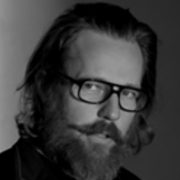
Kerry Brown
Kerry Brown's career as a creator of images can be roughly split into two parts. The first is packed with Kiwi musicians, captured in photos, music videos and concert footage. The second is an album of photographs Brown has taken on film sets around the globe, as an official stills snapper on everything from local classic Once Were Warriors to Prometheus.
Before he left school at 15, Brown's interest in photography was encouraged by an understanding art teacher. Brown was a talented skateboarder, and photos of fellow skaters were his first to win publication. Photography soon vaulted to the top of his interests, and he began documenting musicians and fashion designers around Auckland, and shooting international bands for music mag Rip it Up.
By the mid 80s Brown had begun directing music videos. Bleeding Hearts (1985), for Dianne Swann-led band Everything that Flies, was one of the first. It won him an NZ Music Award (as did this follow-up). The band included Bruce Sheridan, who would later become his filmmaking partner. As company Stratford Productions, Brown and Sheridan worked together on varied promotional videos, fashion shoots, and music clips. Brown directed and was often behind the camera, while Sheridan produced (occasionally directing videos as well).
Brown has argued that in the 1990s local fashion was beginning to look homewards, and take more inspiration from local faces and landscapes. Brown has a Samoan-Kiwi wife (artist Rosanna Raymond), and an appreciation for Polynesian and Māori culture. That appreciation can be seen in Brown's videos for Moana Maniopoto's band (including 1991's AEIOU, the first music video funded by NZ On Air). He also enlisted Samoan-Kiwi artist Greg Semu to co-direct the South Auckland styles of classic track 'In the Neighbourhood', for Sisters Underground.
Brown was lending his talent to a bewildering range of musical acts, from the frenetic video for Shona Laing track 'Drive Baby Drive' to heavy metallers Knightshade, to anthems by The Exponents (the ferns and hot pools of Why Does Love Do This To Me?'and DLT (the urban Pacific-inflected images of Chains).
In 1992 Brown and Sheridan were picked to direct the first Kiwi-made clip for Crowded House: Four Seasons in One Day. Initially Capitol Records were anxious about funding a complex, surrealistic video so far from the United States; but the label's videos manager Mick Kleber later confessed to Crowded House biographer Chris Bourke that the result was one of the few videos he felt good about, from roughly 700 he'd been involved with.
In the same period Brown and Sheridan were working on definitive Split Enz documentary, Spellbound. The two directed together, with Brown concentrating on visuals, and Sheridan concentrating on interviews. Later they worked on videos and an EPK (electronic press kit) for Crowded House album Together Alone, which screened on MTV Europe: Brown also helmed the vid for classic Tim Finn solo track 'Persuasion', Dave Dobbyn hit 'Language', and (with Sheridan) this Dobbyn live concert.
By 1994 Brown had begun dipping his toes into other photographic ventures, after becoming official stills photographer on Once Were Warriors. He went on to take stills for the sequel, plus Scarfies and The Price of Milk. Aside from photographic talent, the job of stills photographer requires strong relationship and negotiation skills, since on a film set they are usually seen as secondary to the needs of the main camera — the one shooting the movie.
Around the turn of the millennium, Brown relocated to London. The plan was to direct music videos, but the timing was awful: around then, "the ass fell out" of the music industry. Trying to start over, in a city packed with photographers, Brown decided to specialise in taking photos for films. His Warriors images opened many doors, but it would be 2009 before he got his big break into studio films: filling in for the final three weeks of Ridley Scott's version of Robin Hood.
Brown managed to persuade reluctant star Russell Crowe to pose for a 'hero image' — aiming a bow and arrow — which was ultimately used on Robin Hood's poster. When Scott began his next film Prometheus, he overruled studio suggestions and made Brown the film's stills photographer.
Since then Brown's career has been increasingly global; from the Colorado locales of Robert Redford romance Our Souls at Night, to the Taiwanese shoot for Martin Scorsese's Silence. Brown headed to the Australian Outback for The Proposition, as well as shooting images for two BAFTA-winners from Kiwi-born producer Finola Dwyer: An Education, and Brooklyn. On smaller projects like these, Brown often films making of footage and interviews, as part of the job.
Brown returned to New Zealand to work on Māori Television documentary The Scotsman and the Māori (2010), about early photographer James McDonald. Brown co-directed, alongside Libby Hakaraia.
Profile written by Ian Pryor
Updated on 29 June 2018
Sources include
Kerry Brown
Kerry Brown website. Accessed 29 June 2018
'The Showtools Sessions: On set stills photographer Kerry Brown' (Video interview) Vimeo website (Broken link). Director Brian Kassler. Loaded 2 March 2016. Accessed 29 June 2018
Dan Ahwa, 'Life through a lens' (Interview; retitled for online publication) - The NZ Herald (Viva liftout), 30 March 2016
Chris Bourke, Crowded House- Something So Strong (Sydney: Pan MacMillan Australia, 1997)